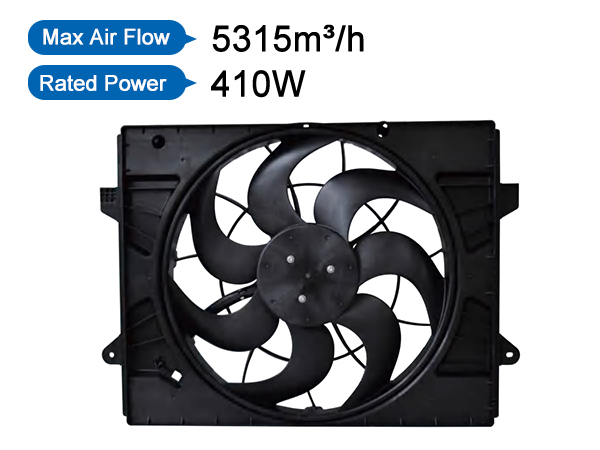In the complex systems of automobiles, the engine cooling system plays a crucial role. It not only ensures that the engine operates at the appropriate temperature, but also extends the service life of the engine. In this system, the car fan plays a central role. This article will explore the relationship between car fans and engine cooling systems, as well as how car fans affect the entire cooling process.

1.The Importance of Engine Cooling System
The main task of the engine cooling system is to maintain the engine operating within the optimal temperature range. The engine generates a large amount of heat during operation, and if this heat is not dissipated in a timely manner, it may cause the engine to overheat, thereby affecting its performance and lifespan. The system mainly consists of coolant, radiator, water pump, thermostat, and our protagonist today - car fan, etc. Therefore, the main task of the engine cooling system is to transfer the heat generated by the engine to the surrounding environment to maintain the engine at its optimal operating temperature. Throughout the process, all components work together to ensure that the engine can continuously and stably output power.
2. Working principle of cooling system
The engine cooling system usually consists of the following parts:
Radiators: responsible for transferring the heat from the engine to the coolant.
Coolant: circulates between the engine and radiator, absorbing and dissipating heat.
Water pump: drives the circulation of coolant in the system.
Thermostat: controls the flow of coolant to maintain the temperature of the engine.
Fan: accelerates the cooling process of the coolant.
3. The function of car fans
1) Forced cooling: Car fans, especially electric fans, automatically start when the engine reaches a certain temperature, generate strong airflow through high-speed rotation, and directly blow towards the surface of the radiator to accelerate heat dissipation. This forced cooling method is more efficient than natural convection and can quickly reduce the temperature of the coolant, effectively preventing engine overheating.
2) Intelligent control: Modern car fans are often equipped with electronic control units (ECUs) for intelligent management. ECU makes comprehensive judgments based on multiple parameters such as engine coolant temperature, vehicle speed, and air conditioning usage status, and accurately controls the opening and closing of the fan, speed adjustment, etc., to achieve the best balance between energy consumption and heat dissipation effect.
3) Coping with extreme working conditions: Under extreme high temperature or low-speed high load conditions, such as driving on congested urban roads, towing operations, etc., the heat generated by the engine significantly increases. At this point, the efficient operation of the fan is particularly important as it can quickly remove excess heat, ensure stable engine operation, and avoid malfunctions caused by overheating.
4. Types of car fans
There are two main types of car fans:
Mechanical fan: Directly driven by the engine, usually starting when the engine reaches a certain temperature.
Electric fan: driven by an electric motor, it can be independently controlled according to needs, making it more flexible and efficient.
5. Collaborative operation of car fans and cooling systems
The car fan works in conjunction with other components of the cooling system to ensure that the engine maintains a suitable temperature under various operating conditions. For example, when the thermostat detects that the coolant temperature is too high, it will open, allowing the coolant to flow through the radiator. At this point, the car fan will also start to accelerate the cooling process of the coolant.
6. The impact of car fan failure
If the car fan malfunctions, it may cause the engine to overheat. This not only affects the performance of the engine, but may also lead to serious mechanical damage. Therefore, regular inspection and maintenance of fans are important parts of car maintenance.
7. Types and Development Trends of Automotive Fans
Car fans are mainly divided into two types: mechanical fans and electric fans. The mechanical fan is directly driven by the engine through a belt, with a simple structure but the speed is proportional to the engine speed, making it difficult to flexibly adjust according to actual needs. Electric fans are completely driven by electricity and can be independently controlled according to ECU instructions, providing higher flexibility and efficiency.
With the continuous advancement of automotive technology, electric fans are gradually replacing mechanical fans as the mainstream. At the same time, in order to further improve cooling efficiency, some high-end models also adopt dual fan or even multi fan designs, as well as more advanced heat dissipation materials and structures, to meet increasingly stringent emission standards and performance requirements.
8. Conclusion
As an important part of the engine cooling system, the performance of the car fan is directly related to the health and safety of the engine. Through efficient heat dissipation, the car fan provides a solid protective barrier for the engine, ensuring stable operation of the vehicle under various working conditions.
Address:No.30, Dapu lndustrial Street, Changping, Dongguan, Guangdong, China
Tel: +86-186 7628 8117